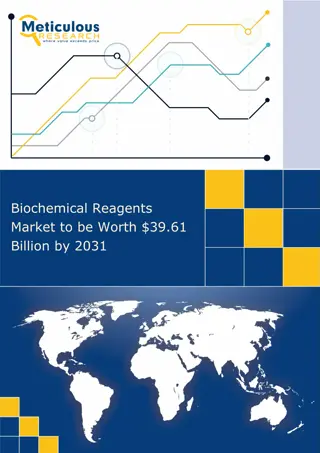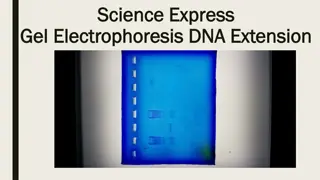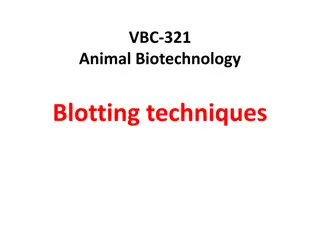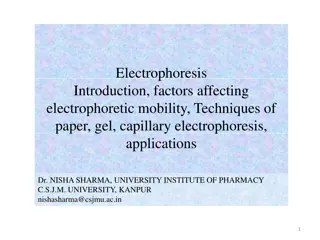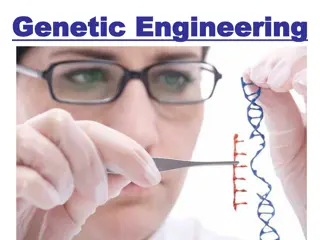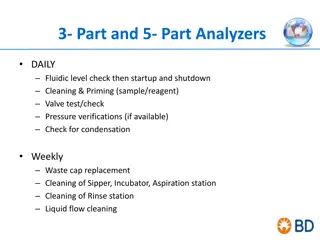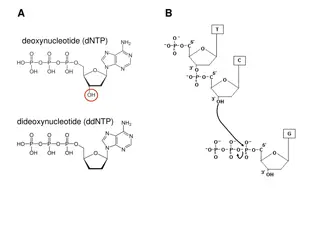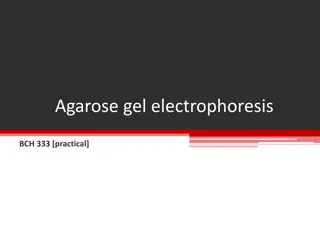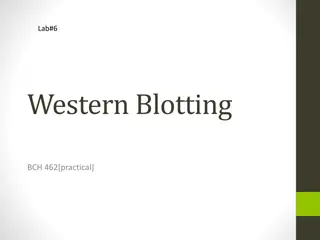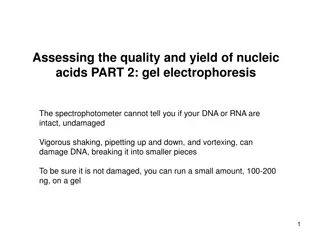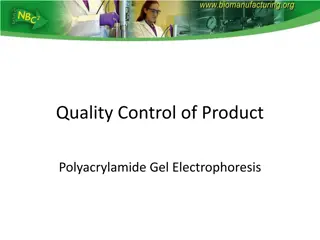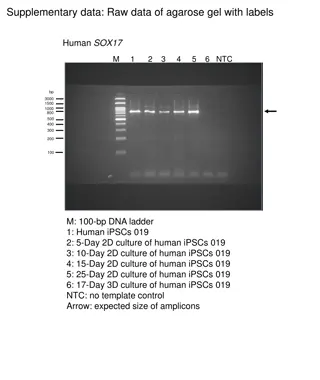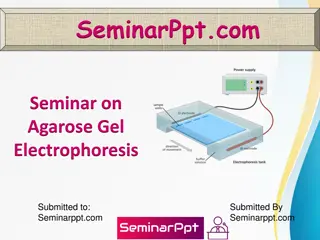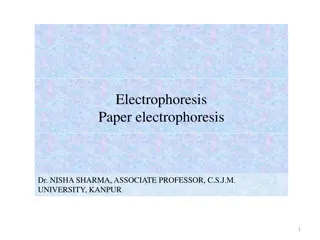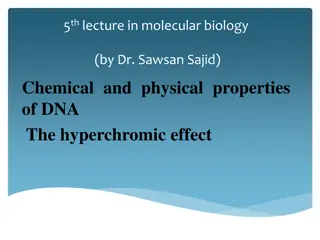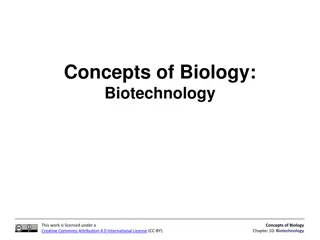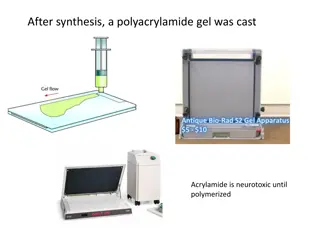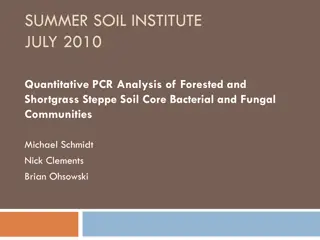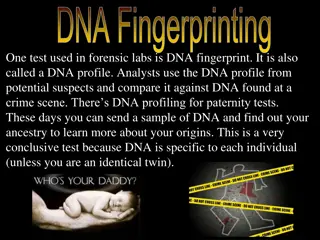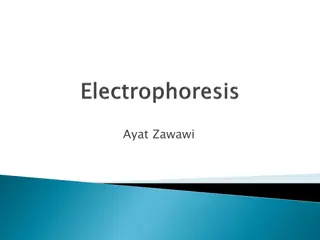Understanding Plasma Proteins and Their Functions
Plasma proteins play a crucial role in various physiological functions such as controlling extracellular fluid distribution and transportation of hormones, vitamins, and other substances. The balance between protein synthesis and catabolism determines protein levels in the vascular compartment, affe
6 views • 23 slides
Biochemical Reagents Market
Meticulous Research\u00ae\u2014a leading global market research company, published a research report titled, \u2018Biochemical Reagents Market by Type (PCR, Chromatography, Cell & Tissue Culture, Flow Cytometry, Electrophoresis, Immunoassay) End User (Pharmaceutical & Biotechnology, CRO, Diagnostic
1 views • 4 slides
Laboratory Techniques for Biologists: Advanced Biology Unit Overview
Explore essential topics in the field of advanced biology including health and safety protocols, risk assessments, dilution methods, colorimetry, separation techniques like chromatography and electrophoresis, and more. Gain insights on handling hazardous substances, controlling risks, and applying v
1 views • 31 slides
Gel Electrophoresis DNA Extension Activity in Modern Biology Lab
This lab activity uses agarose gel electrophoresis to determine the length of an unknown DNA fragment by comparing it to known DNA fragment lengths. The process involves gel preparation, loading samples, electrophoresis, staining, de-staining, and measurement of DNA bands. The activity was produced
0 views • 7 slides
Pulsed-Field Gel Electrophoresis: Separating Large DNA Molecules
Pulsed-Field Gel Electrophoresis (PFGE) is a technique developed to effectively separate large DNA molecules through the application of an electric field that periodically changes direction. This method, introduced by David C. Schwartz and Charles C. Cantor in 1984, revolutionized the resolution of
1 views • 11 slides
Understanding Blotting Techniques in Animal Biotechnology
Blotting techniques such as Southern blot, Northern blot, and Western blot are used to transfer DNA, RNA, and proteins onto a carrier for separation following gel electrophoresis. Developed by E.M. Southern, the Southern blot specifically detects DNA fragments in a sample through hybridization. This
0 views • 30 slides
Understanding DNA Sequencing: Principles, Applications, and Techniques
DNA sequencing plays a vital role in various fields such as research, diagnostics, biotechnology, forensics, and biological systematics. By determining the order of nucleotide bases in a DNA molecule, it helps in understanding genetic sequences, identifying mutations, and completing projects like th
0 views • 17 slides
PCR and Blot Techniques in Molecular Biology
Polymerase Chain Reaction (PCR) is a crucial technique for amplifying specific DNA segments rapidly and accurately. Developed in 1983, PCR is widely used in various fields such as molecular biology, forensics, evolution, and medical diagnostics. On the other hand, the Blot technique transfers DNA, R
0 views • 10 slides
Electric Properties of Colloids in Liquid Media: Charging Mechanisms and Electrokinetic Phenomena
Colloidal particles dispersed in liquid media can acquire a charge through selective adsorption of ionic species or ionization of surface groups. This leads to electrokinetic phenomena like electrophoresis, electro-osmosis, sedimentation potential, and streaming potential. The stability of colloids
2 views • 16 slides
Understanding Electrophoresis: Principles, Techniques, and Applications
Electrophoresis is a technique dating back to principles of electrochemistry, involving the movement of charged particles in an electric field for separation. Factors affecting electrophoretic mobility include charge, particle size, shape, and applied electrical field. Techniques such as paper, gel,
0 views • 22 slides
Understanding Plasma Proteins in Biochemistry Lectures
This informative content discusses the types, functions, and measurement of plasma proteins in biochemistry. It covers the importance of identifying various plasma proteins, their roles in disease diagnosis, and the interpretation of electrophoretic patterns. The lecture overview provides insights i
0 views • 30 slides
Analysis of Experiment Results: Group 20 Presentation
This presentation showcases the experiment results of Group 20, including findings on food samples, gel electrophoresis data, and implications of potential contamination in plant material and GMO presence. The team consists of Canberk from Turkey, Mehmet Tekinalp, and Elin from Denmark's Thisted Gym
0 views • 5 slides
Understanding Genetic Engineering and Selective Breeding
Genetic engineering involves changing the DNA in living organisms to create new traits, resulting in genetically modified organisms (GMOs). Techniques include artificial selection, cloning, gene splicing, and gel electrophoresis. Selective breeding is a form of artificial selection where animals wit
4 views • 37 slides
Genetic Analysis of Corn Muffin Mix: GMO and Plant-Based Findings
A study conducted on Corn Muffin Mix using electrophoresis revealed that the sample is both genetically modified and plant-based. The results suggest that the GMO used in the study may also be genetically modified. The analysis was supported by visual data and information about the Jiffy brand known
0 views • 4 slides
Laboratory Equipment Maintenance Guidelines for Daily, Weekly, and Monthly Tasks
Regular maintenance tasks for various laboratory equipment including analyzers, flow cytometer, automated gel electrophoresis, and micro hematocrit. The guidelines cover daily, weekly, and monthly checks, cleanings, replacements, and verifications to ensure proper functioning and accurate results. T
0 views • 7 slides
Understanding Sanger DNA Sequencing Procedure
Overview of Sanger (dideoxy) DNA sequencing, involving deoxynucleotides and dye-labeled dideoxynucleotides to image DNA band sizes. The simulation model includes steps like denaturing DNA, annealing primers, and synthesizing DNA chains using dNTPs and ddNTPs. The process culminates in electrophoresi
0 views • 7 slides
Understanding Agarose Gel Electrophoresis in Biochemistry and Molecular Biology
Agarose gel electrophoresis is a technique used to separate and analyze DNA or RNA molecules based on size in biochemistry and molecular biology. It involves applying an electric field to move molecules through an agarose matrix towards the positive electrode, with larger molecules moving slower tha
0 views • 11 slides
Understanding Western Blotting for Protein Detection in Biochemistry
Western blotting, also known as protein immunoblot, is a crucial technique for identifying specific proteins based on their ability to bind to antibodies. It involves electrophoresis of protein samples on an SDS-PAGE gel, transferring them to a nitrocellulose membrane, and detecting them using speci
0 views • 17 slides
Gel Electrophoresis for Assessing Nucleic Acid Quality
Gel electrophoresis is a crucial technique for assessing the quality and yield of nucleic acids such as DNA and RNA. It separates DNA fragments based on size, allowing researchers to determine the integrity of the nucleic acids. By running a small amount of sample on a gel and using DNA-binding dyes
0 views • 9 slides
Understanding Quality Control and Electrophoresis Techniques
Exploring the process of analyzing product quality through techniques like polyacrylamide gel electrophoresis, evaluating purity and potency using various testing methods such as cell biology and chemistry. Understanding macromolecular charges, movement of molecules, and the use of agarose and polya
0 views • 30 slides
Raw Data of Agarose Gel for Human Gene Expression Analysis
This supplementary data includes raw data from agarose gel electrophoresis showing gene expression levels for human SOX17, FOXA2, AFP, ALB, and ACTB in various cellular samples. The gel images depict the expected sizes of amplicons for each gene in different conditions and time points of cell cultur
0 views • 5 slides
Gel Electrophoresis in Genetic Engineering: Principles and Types
Gel electrophoresis is a crucial technique in genetic engineering used to separate macromolecules based on size and charge. Agarose and polyacrylamide gels are the two main types used, each with its advantages and disadvantages. Agarose gel electrophoresis is effective for separating large DNA molec
0 views • 14 slides
Understanding Agarose Gel Electrophoresis: A Comprehensive Overview
Agarose gel electrophoresis is a vital technique used to separate DNA, RNA, or proteins based on their physical properties like size and charge. This seminar covers the definition, working process, and applications of agarose gel electrophoresis, shedding light on its importance in molecular biology
0 views • 22 slides
Understanding Nucleic Acid Blotting: Southern Blotting Techniques
Nucleic acid blotting techniques, including Southern blotting, are crucial for transferring DNA, RNA, and proteins for analysis. Southern blotting, developed by Edwin Mellor Southern, is used to probe specific DNA sequences, aiding in applications such as gene isolation, DNA fingerprinting, and dise
0 views • 11 slides
Diagnostic Approaches in Hematologic Disorders: A Comprehensive Overview
Explore the diagnostic considerations for multiple myeloma, monoclonal gammopathy of undetermined significance (MGUS), and related conditions, including indications for serum protein electrophoresis (SPEP) and free light chain (FLC) testing. Learn when not to order SPEP and FLC, and consider various
0 views • 24 slides
Understanding Paper Electrophoresis in Biochemistry Research
Paper electrophoresis is a powerful technique used in biochemistry to separate charged particles like proteins based on their migration along a filter paper strip. This method, conducted by Dr. Nisha Sharma, an Associate Professor at C.S.J.M. University in Kanpur, involves applying samples to the pa
0 views • 17 slides
Understanding the Chemical and Physical Properties of DNA
DNA's characteristics such as absorption of UV light, density measurement using cesium chloride, and size estimation through electrophoresis are key in molecular biology research. The hyperchromic effect, UV light absorption at 260nm, CsCl-density ultracentrifugation, and gel electrophoresis are cru
0 views • 24 slides
Exploring Biotechnology: Concepts and Techniques
Biotechnology encompasses a range of techniques and processes aimed at manipulating biological systems for various applications. This includes methods like PCR for DNA amplification, DNA extraction, gel electrophoresis for DNA fragment analysis, and restriction enzyme processes for DNA manipulation.
1 views • 22 slides
Understanding DNA Fragment Analysis Through Polyacrylamide Gel Electrophoresis
Polyacrylamide gel electrophoresis is a technique used to separate DNA fragments based on size. By casting a gel and running an electric current through it, terminated DNA fragments can be separated and visualized using isotopes. This process allows for the analysis of DNA fragments differing in siz
0 views • 4 slides
Analysis of Bacterial and Fungal Communities in Forested and Shortgrass Steppe Soil
The study conducted in July 2010 at the Summer Soil Institute involved a Quantitative PCR analysis of bacterial and fungal communities in Forested and Shortgrass Steppe Soil. The research compared the microbial DNA extracted from different sites and depths in these ecosystems, using techniques such
0 views • 14 slides
Understanding DNA Fingerprinting and Its Applications
DNA fingerprinting, also known as DNA profiling, is a crucial technique used in forensic labs for identifying suspects or determining paternity. By cutting DNA with restriction enzymes and using gel electrophoresis, DNA fragments are separated according to size to create unique profiles. This highly
0 views • 20 slides
Techniques for Nucleic Acid Estimation and Analysis
Learn about Agarose Gel Electrophoresis for DNA separation, Spectrophotometric method for determining DNA concentration, equipment required, buffer types, DNA markers for size identification, and applications in DNA analysis including paternity testing and crime scene investigation.
0 views • 13 slides
Understanding Electrophoresis and Its Applications in Biochemistry
Electrophoresis is a vital process in biochemistry that allows for the separation and analysis of charged molecules based on factors such as net charge, size, and electrical field strength. This technique, commonly used in DNA analysis and protein separation, relies on the migration of charged parti
0 views • 14 slides

